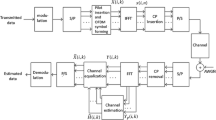Abstract
Orthogonal frequency division multiplexing (OFDM) technology is the key to evolving telecommunication standards including 3GPP-LTE Advanced and WiMAX. Reliability of any OFDM system increases with improved mean square error performance (MSE) of its channel estimator (CE). Particularly, a least squares (LS) based CE incorporating a time-domain denoising threshold, enables better MSE performance, while avoiding the need for a-priori knowledge of channel statistics (KCS). Existing optimal time-domain thresholds exhibit suboptimal behavior for completely unavailable KCS environments. This is because they involve consistent estimation of one or more KCS parameters, and corresponding estimation errors introduce severe degradation in MSE performance of the CE. To overcome the MSE degradation, this paper proposes a weighted-noise threshold, by introducing a modified hypothesis-testing-problem (HTP) interpretation. Derivation of resulting analytical MSE expression is also provided. Results of OFDM system simulations carried out in rayleigh faded ITU-TU6 and WiMAX-SUI4 channel environments with U-shaped power spectral densities, are presented. The performance results show that, compared to many of the existing thresholds, the proposed threshold renders better MSE performance to the CE and higher reliability to the OFDM system in terms of better bit error rate (BER) performance.









Similar content being viewed by others
References
Carlos Augusto, Rocha ACdS and Luciano Leonel Mendes 2007 Performance analysis of channel estimation schemes for OFDM systems. International workshop on telecommunications-IWT. pp 32–36
Coleri S, Ergen M, Puri A and Bahai A 2002 Channel estimation techniques based on pilot arrangement in OFDM systems. IEEE Trans. Broadcasting 48(3): 223–229, doi: 10.1109/TBC.2002.804034
Dai L, Wang Z and Yang Z 2013 Spectrally efficient time-frequency training OFDM for mobile large-scale MIMO systems. IEEE J. Selected Areas Commun. 31(2): 251–263
Hsieh M H and Wei C H 1998 Channel estimation for OFDM systems based on comb-type pilot arrangement in frequency selective fading channels. IEEE Trans. Consumer Electron. 44(1): 217–225, doi: 10.1109/30.663750
Kang Y, Kim K and Park H 2007 Efficient DFT-based channel estimation for OFDM systems on multipath channels. IET Commun 1(2): 197–202, doi: 10.1049/iet-com:20050337
Kashyap S and Mehta N B 2014 Optimal binary power control for underlay CR with different interference constraints and impact of channel estimation errors. IEEE Trans. Commun. 62: 3753–3764
Kay S M 1993 Fundamentals of statistical signal processing, vol. 2, Detection theory. Prentice Hall
Larsson E G, Liu G, Li J and Giannakis G B 2001 Joint symbol timing and channel estimation for OFDM based WLANs. IEEE Comm. Lett. 5(8): 325–327
Lee Y S, Shin H C and Kim H N 2009 Channel estimation based on a time-domain threshold for OFDM systems. IEEE Trans. Broadcasting 55(3): 656–662, doi: 10.1109/TBC.2009.2027575
Minn H and Bhargava V 2000 An investigation into time-domain approach for OFDM channel estimation. IEEE Trans. Broadcasting 46(4): 240–248, doi: 10.1109/11.898744
Morelli M and Mengali U 2001 A comparison of pilot-aided channel estimation methods for OFDM systems. IEEE Trans. Signal Process. 49(2): 3065–3073
Oliver J, Aravind R and Prabhu K M M 2008 Sparse channel estimation in OFDM systems by threshold-based pruning. IEEE Electron. Lett. 44(13): 830–832, doi: 10.1049/el:20081089
Rosati S, Corazza G and Vanelli-Coralli A 2012 OFDM channel estimation based on impulse response decimation: Analysis and novel algorithms. IEEE Trans. Commun. 60(7): 1996–2008, doi: 10.1109/TCOMM.2012.051012.090606
Sheng B 2014 Blind timing synchronization in OFDM systems by exploiting cyclic structure. Trans. Emerging Telecommun. Technol. 25(2): 155–160, doi: 10.1002/ett.2563
van de Beek J J, Edfors O, Sandell M, Wilson S and Ola Borjesson P 1995 On channel estimation in OFDM systems. In: IEEE 45th vehicular technology conference, vol 2, pp 815–819, doi: 10.1109/VETEC.1995.504981
Xie H, Andrieux G, Wang Y, Diouris J F and Feng S 2013 Efficient time domain threshold for sparse channel estimation in OFDM system. AEU-Int. J. Electron. Commun. 68: 277–281
Zhinian L and Wenjun Z 2007 Simulation for correlated rayleigh fading channels by FIR pulse-shaping filtering. In: International conference on wireless communications, Networking and Mobile Computing, pp 1091–1094, doi: 10.1109/WICOM.2007.279
Author information
Authors and Affiliations
Corresponding author
Appendix: proof of conditional expectations (24) and (25)
Appendix: proof of conditional expectations (24) and (25)
With the modified hypothesis shown in (16), the modified event III, namely \({{\left ({\left |{\hat h_{i,n}}\right |^{2} > \vartheta }\right )}/{\left ({\left | {h_{i,n}} \right |^{2} \le \left | {v_{i,n}} \right |^{2}}\right )}}\) occurs with a probability of P F A . In this case, though actual tap is not present, the threshold detects as tap is existing, thus causing a squared error of \(\left | \bar v_{i,n} + v_{i,n} \right |^{2}\). The mean of this squared error is given in (29) and (30).
Using Baye’s theorem, the conditional density function is given in (31).
Simplifying (31), we get (32), which is used in (30), to finally obtain (24).
On similar lines as above, modified event IV, \({{\left ({\left | {\hat h_{i,n}} \right |^{2} < \vartheta }\right )}/{\left ({\left | {h_{i,n}} \right |^{2} \le \left | {v_{i,n}} \right |^{2}}\right )}}\) has a probability of \(\left (1-P_{FA} \right )\). In this case, the actual tap is not present, and the threshold also detects as no tap. Though the threshold identified correct, due to modified H 0 in (16), a squared error of \(\left | \bar v_{i,n} \right |^{2}\) exists. The mean of this squared error is simplified similar to that on event III to finally obtain (25). The conditional density function used in deriving (25) is (33).
Rights and permissions
About this article
Cite this article
SURE, P., BHUMA, C.M. Weighted-noise threshold based channel estimation for OFDM systems. Sadhana 40, 2111–2128 (2015). https://doi.org/10.1007/s12046-015-0438-7
Received:
Revised:
Accepted:
Published:
Issue Date:
DOI: https://doi.org/10.1007/s12046-015-0438-7




